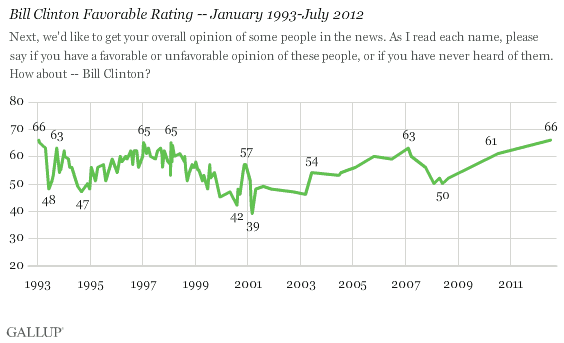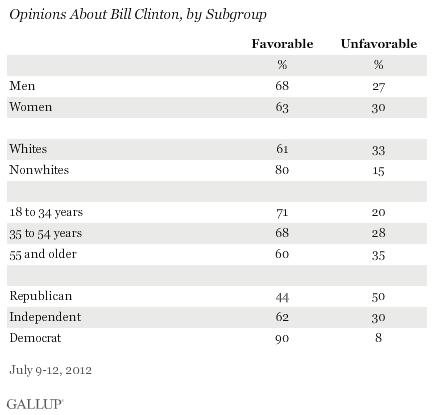PRINCETON, NJ -- Two-thirds of Americans -- 66% -- have a favorable opinion of former U.S. President Bill Clinton, tying his record-high favorability rating recorded at the time of his inauguration in January 1993. Clinton nearly returned to this level of popularity at two points in his second term, but has generally seen lower ratings, averaging 56% since 1993.

Clinton's popularity could make him one of the more valuable speakers at the 2012 Democratic National Convention later this summer, where he will reprise his 2008 convention role as booster-in-chief for Barack Obama. Hillary Clinton's favorable rating was also 66% in Gallup's most recent measure. Obama himself is viewed favorably by 54% of Americans.
Along with his record-high favorable rating, Clinton now has a near-record-low 28% unfavorable rating, according to the July 9-12 Gallup poll. The only times since 1993 that his unfavorable rating has been lower -- 26% and 27% -- were in January of his inaugural year.
Clinton Broadly Liked, Including by Nearly Half of Republicans
Clinton is viewed favorably today by most men, women, whites, and nonwhites, and across all major age groups. He also enjoys broad favorability among independents as well as Democrats. And while more Republicans view him unfavorably than favorably, it is by a relatively narrow 50% vs. 44% margin.

Clinton had one of the shorter honeymoon periods in modern presidential history, with his presidential job approval rating descending below 50% within four months of his taking office -- a pattern mirrored in his favorable ratings. His favorables largely recovered in late 1993, but fell again in 1994, shortly before the midterm elections that resulted in Republican majorities in both houses of Congress for the first time in 40 years.
Clinton weathered the Monica Lewinsky scandal in 1998 with fairly high personal ratings -- averaging 58% that year -- and ended his presidency on a positive note, with a 57% rating in December 2000. Within three months, however, his favorable rating fell to an all-time low of 39%, amid controversy over some of his last-minute presidential pardons.
Since 2001, Americans have generally had a positive view of Clinton, although this faltered during the 2008 Democratic primary season when the former president took an active role in his wife Hillary's campaign against Barack Obama. After falling to 50% in late May/early June of that year, Clinton's favorable rating remained in that range, at 52% just before the 2008 Democratic National Convention. That included a subdued 79% favorable rating among Democrats, 51% among independents, and a mere 18% among Republicans.
The difference in Clinton's popularity then and now is underscored by changes in his favorable rating among different demographic groups. The biggest improvement has occurred among Republicans, with his favorable rating registering 44% today vs. 18% in August 2008 -- a 26-percentage-point increase. At the same time, his popularity has improved at a rate similar to the sample average of 14 points among men, women, whites, nonwhites, independents, and Democrats.
Bottom Line
In 2008, former President Bill Clinton was a crucial symbol of party unity at the Democratic National Convention as Obama sought to win over former supporters of Hillary Clinton. While not wildly popular with any key voting blocs at that time, he sent an important intra-party signal that it was time to come together around Obama.
By contrast, Clinton's solid popularity with Americans today might help attract new support to Obama from outside the party, particularly from whites, men, seniors, and political independents -- all important voting groups that Obama is struggling with in trial heats against Republican Mitt Romney.
Survey Methods
Results for this Gallup poll are based on telephone interviews conducted July 9-12, 2012 with a random sample of 1,014 adults, aged 18 and older, living in all 50 U.S. states and the District of Columbia.
For results based on the total sample of national adults, one can say with 95% confidence that the maximum margin of sampling error is ±4 percentage points.
Interviews are conducted with respondents on landline telephones and cellular phones, with interviews conducted in Spanish for respondents who are primarily Spanish-speaking. Each sample includes a minimum quota of 400 cell phone respondents and 600 landline respondents per 1,000 national adults, with additional minimum quotas among landline respondents by region. Landline telephone numbers are chosen at random among listed telephone numbers. Cell phone numbers are selected using random-digit-dial methods. Landline respondents are chosen at random within each household on the basis of which member had the most recent birthday.
Samples are weighted by gender, age, race, Hispanic ethnicity, education, region, adults in the household, and phone status (cell phone only/landline only/both, cell phone mostly, and having an unlisted landline number). Demographic weighting targets are based on the March 2011 Current Population Survey figures for the aged 18 and older non-institutionalized population living in U.S. telephone households. All reported margins of sampling error include the computed design effects for weighting and sample design.
In addition to sampling error, question wording and practical difficulties in conducting surveys can introduce error or bias into the findings of public opinion polls.
View methodology, full question results, and trend data.
For more details on Gallup's polling methodology, visit www.gallup.com.
